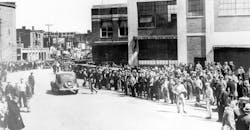Without meaning to seem crass or oblivious to the reality of the situation, there is something rather reassuring to me about the United Auto Workers union’s ongoing strike against the Big Three automakers. It’s the formality of the situation, the declaration of intent on both sides, and the adherence to the traditional procedures of organized labor forcing public companies to conduct an open negotiation that may be observed and perhaps influenced by the public. In the past, strikes could be bitter or tense, but the negotiation effort made it implicit that both labor and management understood that they needed each other, and that their futures were intertwined. That would be encouraging.
In fact, the current strike is nothing like those of the past, and the first signal of that was the UAW choosing to target individual plants of all three manufacturers – Ford, General Motors, and Stellantis. The traditional approach would be to pick one partner, hammer out the best labor agreement that can be gotten, and then corner the other two employers into accepting those terms or appear obstinate in the eyes of the car-buying public.
The 2023 move against all three signals that to the UAW the negotiating process is not primarily an effort to get a deal but to expose the circumstances for its membership in today’s automotive sector. They’re not satisfied, of course, and they have presented their demands for their wages to be increased (36% increase over four years) and benefits enhanced. In particular, the union is demanding that the automakers toss out the terms settled on more than a decade ago when workers’ and retirees’ benefits threatened to smother the three companies, and the UAW accepted a tiered wage structure for different job assignments. Everyone should be on the same wage scale, the union insists.
Among other benefit demands, the UAW wants its members to work 32 hours/week; a return to defined-benefit pensions for new hires; and restored cost-of-living pay raises. It’s hard to escape the impression that the union is hoping to reset the clock to 2009, or even earlier.
By going after the entire domestic industry at one time, by demanding a return to former wage/benefit schemes, and particularly by its public statements, the UAW is conjuring memories of union solidarity to embolden its members and draw public sentiment to its side. UAW president Shawn Fain’s public statements are stirring the pot of social justice too, arguing that the automakers’ income statements and executive pay scales reveal an industry that is cheating its workers. “The money is there. The cause is righteous. The world is watching,” Fain declared in September.
In this the UAW does have a sense of the present moment, but the financial strain on autoworkers is not primarily the fault of their employers. The distress over economic disparities is properly directed at the regulatory and fiscal policies that shape the U.S. economy, in which UAW members and the entire population have endured average inflation rates of 6-7% during the past three years (though less so, YTD.)
UAW leaders perhaps believe that federal officials will help them put the Big Three on the spot, which is the politicians’ traditional role in industrial labor disputes. But they’re living in the past if they do not recognize that today’s domestic auto industry is largely a creation of federal policies.
It has not been consumer demand that marshalled all automakers to institute electric vehicle development and manufacturing programs that now anchor those corporations. Car buyers as a group are unpersuaded that EVs are necessary or desirable for them. Their opinions have not been improved by the unaffordability of those new products.
The union is definitely on the wrong side of history in respect to EV manufacturing: UAW members are employed in manufacturing activities directed at internal combustion-engine vehicles, which are a depreciating asset to the industry and the regulators who mandated it so. The union is demanding a greater role in the operations that produce EVs – but that’s not likely to be an option the Big Three concedes: The prices of those vehicles are already scaring away buyers; why would GM or Ford, or Stellantis agree to lay union-scale labor on top of their manufacturing costs? That is the problem the auto industry is trying to overcome, so it can live up to promises it has made about future products and services.
The present reality is that the UAW and its Big Three targets are not negotiating so that they can work together in the future. They’re living in different dimensions. One side is updating the present with ideas and impressions from the past, and the other is working out the difficulties of escaping this moment for better times ahead.
About the Author
Robert Brooks
Content Director
Robert Brooks has been a business-to-business reporter, writer, editor, and columnist for more than 20 years, specializing in the primary metal and basic manufacturing industries. His work has covered a wide range of topics, including process technology, resource development, material selection, product design, workforce development, and industrial market strategies, among others.
